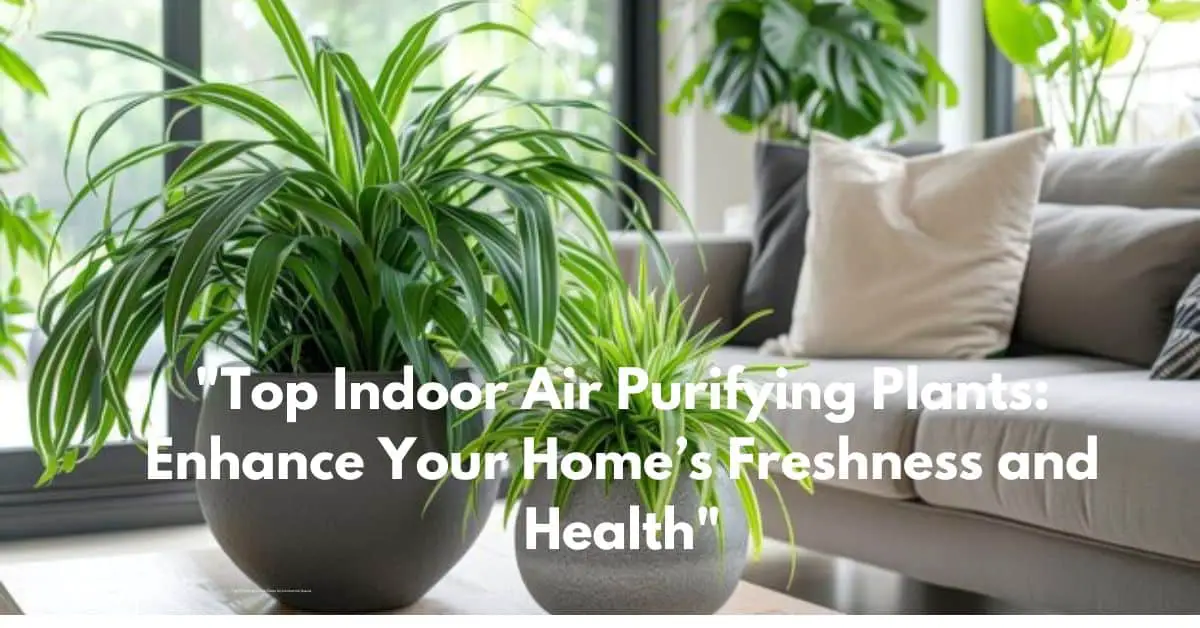Air purifying plants can remove toxins such as formaldehyde, benzene, and carbon monoxide from the air, making your indoor environment healthier. NASA’s Clean Air Study has even shown that certain plants can act as natural air filters, reducing airborne toxins and boosting oxygen levels. When I added a few of these purifying plants to my home, I noticed a fresher, lighter atmosphere—and I didn’t have to invest in air purifiers!
Table of Contents
Why Choose Air Purifying plants?
Indoor air quality can sometimes suffer due to dust, cleaning products, and everyday pollutants. Thankfully, plants do much more than add aesthetic appeal—they can improve air quality, making your home fresher and healthier. In this post, we’ll dive into some of the top indoor air purifying plants, share personal experiences, and provide care tips to ensure these green companions thrive in your space.
Best Indoor Air Purifying Plants
Here’s a look at some of the top indoor plants known for their air-purifying abilities:
1. Snake Plant (Sansevieria trifasciata)
Snake plants, also known as Mother-in-Law’s Tongue, are one of the best indoor air purifiers. They’re low-maintenance, durable, and can survive in low light conditions, making them ideal for beginners.
- Purifying Power: Removes toxins like formaldehyde, benzene, and xylene.
- Light Requirements: Can tolerate low to bright indirect light.
- Watering Needs: Water sparingly, allowing the soil to dry out completely between waterings.
Personal Tip: I keep a Snake Plant in my bedroom, as it releases oxygen even at night, helping me sleep better. This hardy plant has been a constant in my home—it requires very little care and still thrives.
2. Spider Plant (Chlorophytum comosum)
The Spider Plant is another easy-care favorite that has earned its spot as a top air purifier. Its delicate, arching leaves look beautiful in hanging baskets or on shelves.
- Purifying Power: Effective at removing formaldehyde, carbon monoxide, and xylene.
- Light Requirements: Thrives in indirect sunlight but can tolerate low light.
- Watering Needs: Water when the top inch of soil feels dry.
Personal Tip: I keep a Spider Plant near my desk. Not only does it add a splash of green to my workspace, but it’s also low-maintenance and has been known to help reduce indoor air pollutants commonly found around electronics.
3. Peace Lily (Spathiphyllum)
Peace Lilies are beloved for their stunning white blooms and their ability to remove toxins. They also increase humidity, which can be particularly beneficial in drier homes.
- Purifying Power: Removes ammonia, benzene, and formaldehyde.
- Light Requirements: Prefers medium to low light.
- Watering Needs: Keep soil consistently moist; avoid letting it dry out completely.
Personal Tip: My Peace Lily sits near the entrance, where it brightens up the space and greets guests. Its low-light tolerance makes it perfect for spots that don’t get much sun, and its air-purifying qualities add to its appeal.
4. Aloe Vera
Aloe Vera is not only famous for its soothing gel but also for its air-purifying properties. It’s a resilient plant that can add a desert vibe to your space while keeping the air clean.
- Purifying Power: Removes formaldehyde and benzene.
- Light Requirements: Prefers bright, indirect sunlight.
- Watering Needs: Water sparingly, especially in winter.
Personal Tip: I keep an Aloe Vera plant in the kitchen. Aside from its air-purifying qualities, its gel can come in handy for burns or cuts. This plant thrives on very little water, making it a practical choice for busy people.
5. Boston Fern (Nephrolepis exaltata)
Boston Ferns add a lush, tropical feel to any room, and they’re excellent at removing airborne pollutants. They also act as natural humidifiers, adding moisture to dry indoor air.
- Purifying Power: Known to remove formaldehyde and xylene.
- Light Requirements: Bright, indirect sunlight.
- Watering Needs: Keep soil consistently moist and mist frequently for humidity.
Personal Tip: I added a Boston Fern to my living room, and it’s been fantastic for adding a tropical look while keeping the air clean. However, it does need regular misting, so it’s ideal if you’re willing to give it a little extra care.
6. Rubber Plant (Ficus elastica)
The Rubber Plant is a powerful air purifier that’s known for its large, attractive leaves and ability to remove toxins from the air.
- Purifying Power: Effective at removing formaldehyde.
- Light Requirements: Prefers bright, indirect light but can tolerate low light.
- Watering Needs: Water when the top inch of soil is dry.
Personal Tip: I keep a Rubber Plant in my hallway, where it adds a touch of elegance and does a great job of improving air quality. This plant is surprisingly easy to care for and doesn’t mind if I occasionally miss a watering.
Simple Care Tips for Indoor Air Purifying Plants
If you’re just starting with indoor plants, here are a few tips to keep them thriving:
1. Find the Right Spot
Most indoor air purifying plants do well in indirect sunlight, though each plant has its specific needs. Snake Plants and Peace Lilies are perfect for low-light areas, while Aloe Vera and Rubber Plants prefer brighter spots. Observe each plant to see how it responds, and make adjustments as necessary.
2. Water Wisely
Overwatering is a common mistake, especially with plants like Snake Plants and Aloe Vera that don’t need much water. Before watering, check the top inch of soil; if it’s dry, it’s time to water. Keep in mind that plants like the Boston Fern need more consistent moisture.
3. Boost Humidity When Needed
If you live in a dry climate or keep your home heated during winter, some plants will need a little extra humidity. Mist your ferns and Peace Lilies regularly or place a humidifier nearby.
Decorating with Indoor Air Purifying Plants
Indoor air purifying plants aren’t just functional; they’re also beautiful decor elements that can enhance your home’s ambiance. Here are some ideas for integrating them into your decor:
- Create a Relaxing Corner: Arrange a few purifying plants like Peace Lilies, Spider Plants, and a Boston Fern in a cozy corner of your living room. This can become your designated relaxation space where you can feel calm and refreshed.
- Bedroom Greens: Snake Plants and Rubber Plants are ideal for the bedroom since they require minimal care and improve air quality, enhancing the sleep environment.
- Workspace Boost: Place an Aloe Vera or a small Spider Plant on your desk. These plants are low-maintenance and can help reduce indoor pollutants from office electronics.
My Experience: Breathing Easier with Indoor Air Purifying Plants
Adding air-purifying plants to my home has made a noticeable difference in both air quality and aesthetic appeal. I initially began with a Snake Plant in the bedroom, hoping it would help with nighttime air quality, and soon noticed an improvement. Inspired by this, I added a Peace Lily near my entryway and a Spider Plant by my workspace. These plants not only keep the air cleaner but also add a sense of calm and connection to nature that makes my home feel more inviting.
Conclusion
Indoor air purifying plants are a natural way to create a healthier, fresher home environment. From the resilient Snake Plant to the lush Boston Fern, these plants offer beauty, style, and improved air quality for every room. If you’re looking to start an indoor garden, these air-purifying plants are an excellent place to begin.
Whether you’re a seasoned plant lover or new to indoor gardening, these air-purifying plants bring both beauty and health benefits to your space. So, take a breath of fresh air—literally—and add some green power to your home today!










